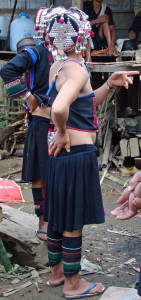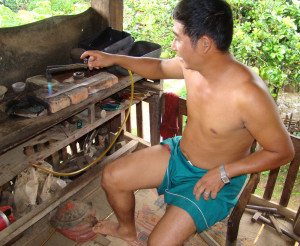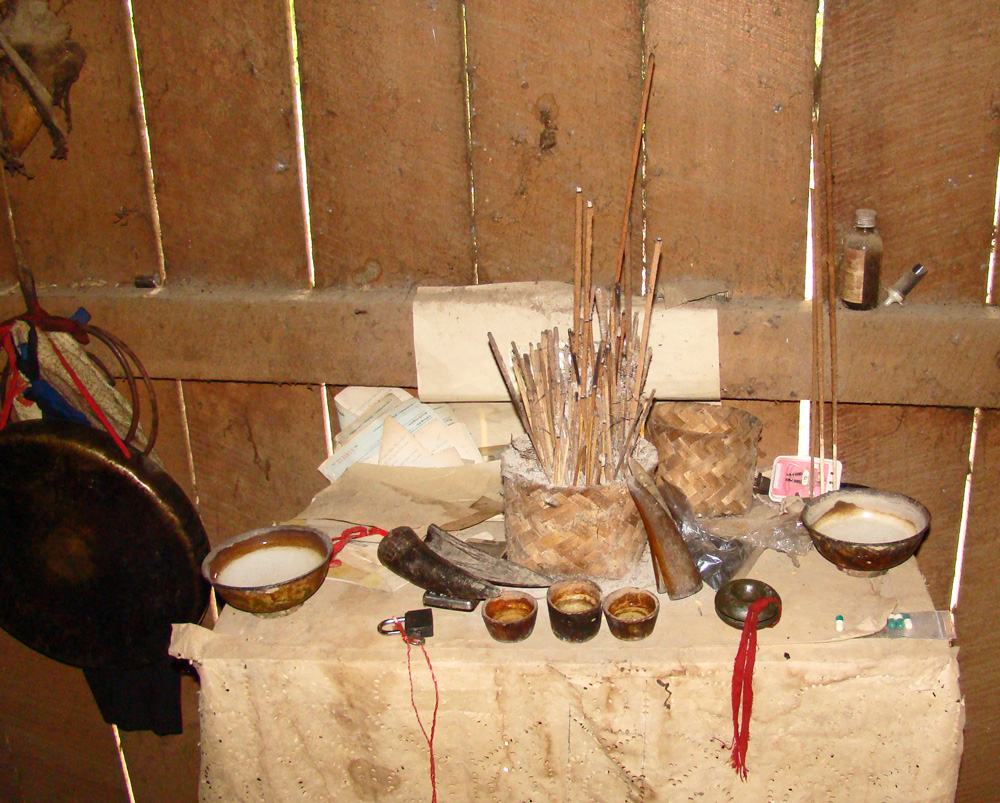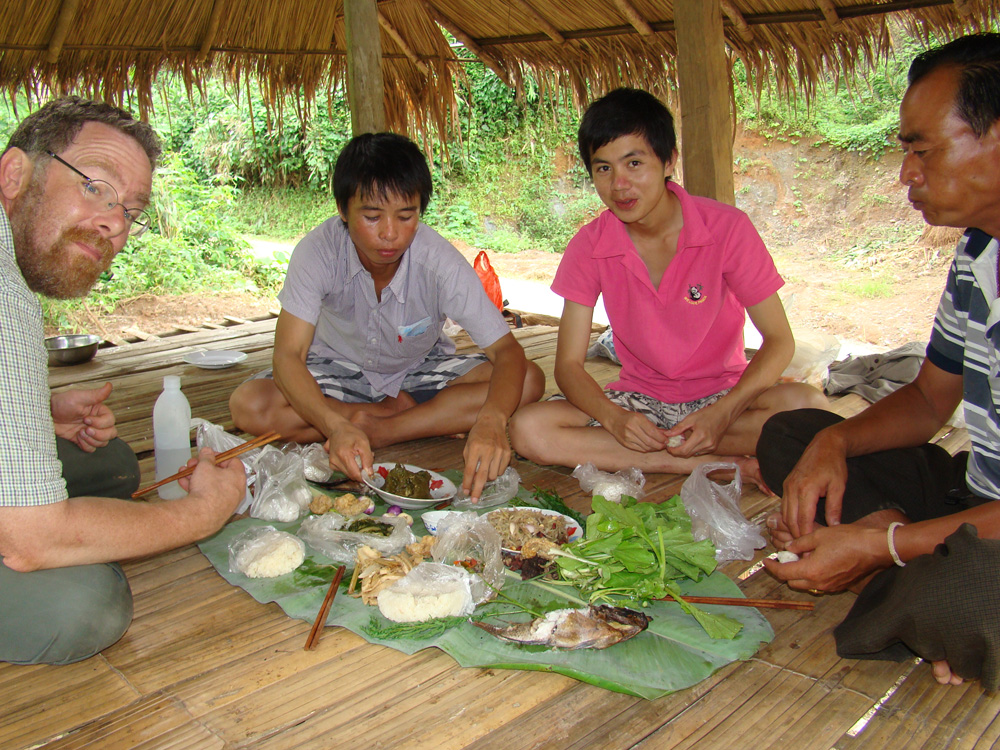Notes from a Thatched-Roof Hut
At the moment of writing these words, we are sitting in a thatch-roofed bamboo hut on the side of verdant rice patties watching two Akha women work the rice field opposite, while Tui, our guide, translator and friend, is cooking lunch for us on a fire below. These crude open-sided shelters are built primarily for use during planting and harvest seasons, and allow the field-workers to get reprieve from the sun, grab a meal or nap, or camp out overnight. But anyone is welcome to use one. We have an internet connection here, between Muang Long and Xieng Kok in NW Laos, about 8 miles from the border with northern Myanmar, because Tui has a mobile internet connection! He just plugged it in, logged us on, and here we are! Amazing.
The town of Muang Long is wonderful. We are the only falang (literally “French”, but it refers to any westerner) we’ve seen in a week, except for a passing hello from Scott (of Maryland), who works with an agricultural NGO helping villages develop fish ponds and better planting techniques to improve consistency in food production. We are staying in a newer guesthouse in Muang Long that is owned by Tui’s sister. It’s a clean, simple, cement-block cube with a double bed, an overhead fan, and an attached bathroom with a squat toilet and a shower snozzle; joyful news – there is actually a hot-water- on-demand system. Tui is just as we remember him from 2006 – funny, kind and full of information on local cultures and people.
One question we are asked is how we present ourselves, as business-people, in small villages. How do we respectfully inquire if they have tribal arts available? Some villages, such as Xam Tai, are known weaving centers and new textiles are readily available for the inquisitive. Larger villages have open-air markets where business conversations are anticipated. But what about the small subsistence farming villages? One reason we love Tui is that he has an incredibly disarming and respectful approach.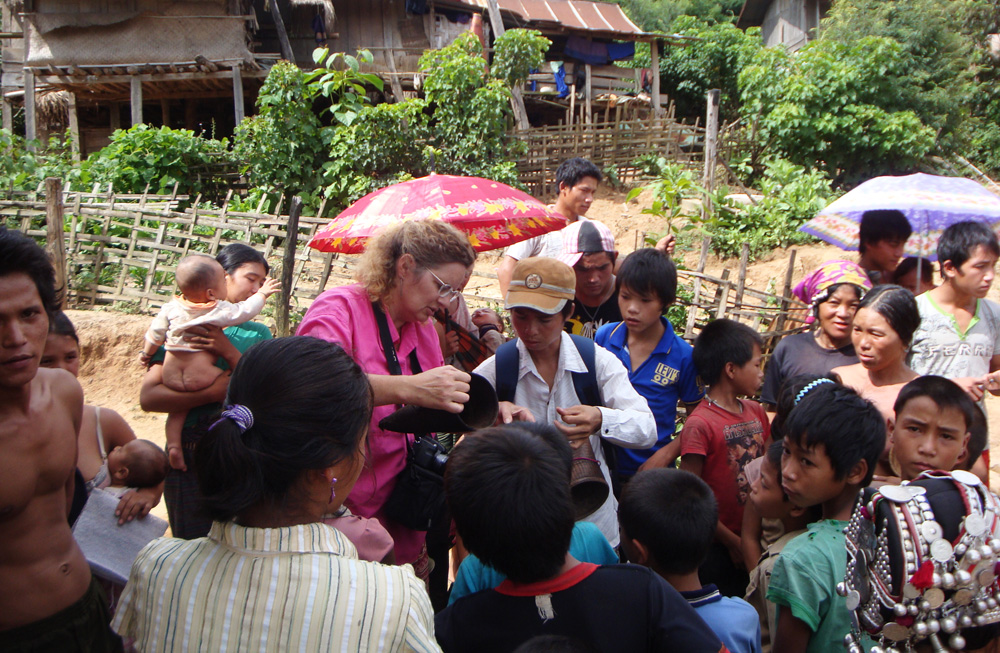
This morning we visited Cha Kan Tanh. This village of perhaps 200 Akha people is about 2 km off the sealed road; the path to the village is well-worn by years of small motorcycle and foot traffic – a swaying, wooden plank bridge about 2-1/2 feet wide crosses the shallow river. The village is set on a knoll of hard-packed dirt, and the first sizeable home we encounter is wood-sided with a thatched roof, perhaps 500 square feet, and, like the other homes, set about 8 feet off the ground on thick wooden posts. The area under the home has wooden boards where two local children are sitting; stored under the home are farm tools, baskets, bamboo poles, and projects that need protection from the monsoon rains.
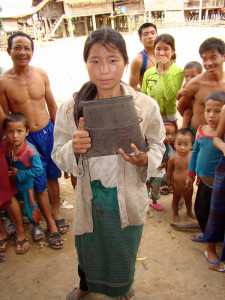
With other villagers laughing in the background, a young lady poses with her basket that she wanted to sell in Cha Kan Tanh village, Laos.
Today, however, it is humid and hot – the sun at this latitude feels close to the Earth. Tui and the two of us walk patiently up to the home and sit down on the benches. A couple children come over to ogle, and soon an adult, a woman in an Akha headdress, appears from upstairs. Tui says nothing at first, waiting for the sweat to dry on his face. He smiles and nods and then, in the Akha language, offers a “good morning,” which brings toothy smiles. The woman’s adolescent daughter brings out a tea kettle with three well-worn, unwashed glasses, and she proceeds to fill them with the light brown, boiled water (we ignore the “floaters”). We politely accept and, despite what our doctors might advise, take a draught. Tui looks around at the village scene, downs his water in a gulp, and doesn’t say anything for a full minute.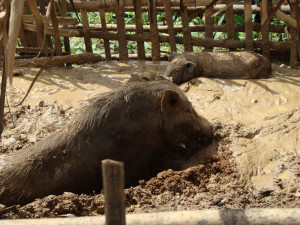
Tui begins by asking about the health of the village. It turns out that the night before a pig had given birth, not in the sty but in the village – a taboo. To appease the spirits, the pig that morning had been ritually slaughtered (and was to be eaten); thus most of the village members were not at work in the fields this morning, needing to attend to spiritual needs. “And the piglets?” Maren asks, “Did they also ….” “Yes, of course” Tui replies to us without asking our hosts.
As we share quiet pleasantries in the shade, other villagers start to drop by. One elder comments that we are the first white people in his memory to ever have visited their village, and everyone agrees; while tourists have zoomed by on buses and cars and motorcycles on the nearby road, none had ever walked the extra 20 minutes to this beautiful village. In Laos, one can easily “get remote.”
Tui notices a particularly beautiful basket one villager is carrying, and he asks to look at it. He turns it over in his hands, and shows it to us. We all complement the basket-weaver’s talent, and this opens a conversation about who makes the local baskets. Tui also notices other items under the home – a couple of digging tools, a basket for catching fresh-water eels, a wooden plow. Tui is as interested in the cultural knowledge as we are (and keeps making Akha-language notes in his journal), and we all ask many questions about how the items around us are made and used.
More people join the hubbub. Soon locals are demonstrating how to bait eels, and another brings us a sample of the vines used for making shoulder bags. Tui, who used to be an elementary school teacher, starts teasing the once-skittish kids, and then he dons a small women’s basket and, to gales of laughter, mimes being a woman going off to the fields. About 60 Akha villagers now crowd in tightly, and, with more gales of laughter, watch our clumsy-fingered attempts to bait a delicate bamboo bird trap. By this time Tui has let the villagers know that we are collectors of quality tribal art who look for baskets and other wares that people might like to sell.
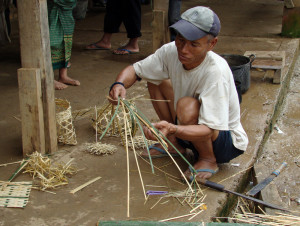
“Hex” symbols are being woven for the ceremony to appease the spirits of the rice fields and ensure a good crop.
Tui describes that we only seek baskets that are worn, but still whole. We bargain lightly for one Akha gathering basket with a deep warm patina; a few locals see the dynamic and over the next hour we are shown a variety of used baskets that the locals are willing to sell. The price stays stable – bargaining is inappropriate in rural Laos assuming a reasonable price is originally requested. In truth, cash is a valuable and rare commodity in the village, whereas basket-weaving materials and skills are indigenous. Another local brings us some finished piat shoulder bags that she had intended to sell at a nearby market; might we be interested? As we are “ooh-ing and ahh-ing” over baskets and textiles, we request if we can take photos of those selling us items. Most are eager to pose and then laugh as we share the picture on the camera’s viewing screen (we’ll bring them copies of the photos when we return). Some of the older women are bare-chested, but most cover themselves with a loose vest before posing for a photo; some choose not to have their photo taken at all. We are careful not to photograph small children alone who are thought to have more vulnerable spirits.
The skirts in this village demand some attention, as they are the lowest of the low- slung! It makes western “low-riding” pants look “square”. Most of the local Akha woman here wear a skirt that rides down around their backside to expose at least half their complete rears and rests underneath their bellies. What keeps these skirts up at all for modest coverage seems to defy the laws of physics!
Every village offers a different adventure. In one Akha village, in an open-air shop set like a watch-tower with a magnificent valley view, we shared time with a silversmith who was making a new set of ornaments for an Akha woman’s headdress. At another village, we talked at length with two women about piat, the jungle vine that is used to make fishing nets and knotted bags. Maren got a hands-on lesson on how to use a drop spindle – Tui said Maren was a natural – and she also learned to splice piat to make the string used for their nets and bags. The Akha ladies laughed and said Maren, with these new-found skills, was now an Akha! It helps to have patient teachers. A lot of their newer woven carrying bags are made from market nylon, or from used plastic rice-bags and tarps (those blue tarps are everywhere!). The Akha women simply undo the bags and tarps into fine stripes, and use the drop spindle to twist it into “yarn”.
At yet another village, we arrived toward the end of the weaving of a dozen bamboo “hex” symbols, three simple baskets, and a larger hex that were going to be part of the ceremonial offering to the spirits of the rice fields. The baskets were to each hold a chicken that would be sacrificed for the offering. Tui motioned to us to wait back a bit until he checked to see if it was OK for us to come near during the weaving of these objects to be used in a sacred ceremony. The locals said it was OK, and we were even allowed to take photos. No, we didn’t ask about acquiring a “hex.”
Not every village has things to purchase. Often we get a treat of traditional art only for viewing – just yesterday a shaman showed us his tools to appease the spirits – but of course a shaman’s tools are not for sale and we would never think to inquire as to such. Another village was stricken with grief at the loss of a 5-year- old; we shared glasses of weak tea, paid our deepest respects, and then excused ourselves.
We can smell the fresh fish that Tui is cooking on the small lunch-time fire. In the middle of the hut, set out on a banana-leaf table, is the dried buffalo meat, a spicy eggplant dish, some pickled cabbage, fried pig skin, a cooked green leafy vegetable moosh, bamboo shoots, fresh aubergines, greens just pulled up from the edges of the rice field and rinsed in the watering stream next to the hut, and sticky rice that Tui has pulled out from his small pack to accompany the delectable fish. Ah well… here’s to our image of being rugged, outback adventurers on the “edge of civilization.“
Oh boy – lunch is on…..


